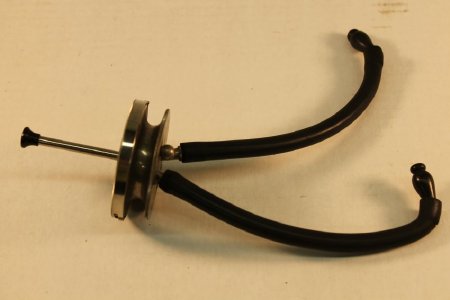Object ID Number:
EH10816
Object Name:
Stethoscope
Type:
Phonendoscope
Manufacturer:
Pilling
Date of Manufacture:
1894/ /
Manufactured from:
1894
Manufactured to:
1935
Description / History:
Phonendoscope c.1894
This piece represents one of the many variations on the diaphragm stethoscope designed in the late 19th century. These stethoscopes specialized in picking up higher pitched sounds.
In 1894, Italian physicians Eugenio Bazzi and Aurelio Bianchi introduced their new instrument for listening to the sounds made by the body's organs. The metal base was fitted with an inner diaphragm and a removable outer disc, both made of rubber. A metal rod holding a smaller rubber disk was inserted into the center, and it was this part which was placed on the patient's skin. The inventors claimed that the phonendoscope was more sensitive and accurate than other stethoscopes. Although this claim was soon disputed, it remained in production for over 40 years.
This piece represents one of the many variations on the diaphragm stethoscope designed in the late 19th century. These stethoscopes specialized in picking up higher pitched sounds.
In 1894, Italian physicians Eugenio Bazzi and Aurelio Bianchi introduced their new instrument for listening to the sounds made by the body's organs. The metal base was fitted with an inner diaphragm and a removable outer disc, both made of rubber. A metal rod holding a smaller rubber disk was inserted into the center, and it was this part which was placed on the patient's skin. The inventors claimed that the phonendoscope was more sensitive and accurate than other stethoscopes. Although this claim was soon disputed, it remained in production for over 40 years.
Dimensions:
H–2 W–4 L–5 inches
Additional Information:
Stethoscopes are acoustic devices used for auscultation–listening to the internal sounds of the human body. Today, physicians commonly use stethoscopes to listen for sounds of the heart, lungs, intestines and blood vessels.
The earliest stethoscope was famously used in 1816 by the French physician René Laennec. That year, Laennec was examining a young woman with heart trouble. She was quite stout and well–endowed, physical qualities which obstructed Laennec's attempts at using the traditional auscultatory technique of applying his ear directly to the patient's chest. He also found the use of this technique to be considerably embarrassing, and sought out an alternative method of listening to her heart. In desperation, Laennec rolled 24 sheets of paper into a compact cylinder and pressed it against his patient's chest. To his relief, his modesty was preserved, and he found that he was able to hear the sounds of her heart with more clarity than ever before.
In the years following Laennec's discovery, many instruments were developed attempting to replicate the utility of Laennec's paper cylinder. Known collectively as "monaural" (one–eared) stethoscopes, these instruments, made initially from wood, and later from metal, resembled candlesticks, with a thin shaft, a flat earpiece, and a conical chest–piece. Later, in the 1850's, physicians discovered that binaural (two–eared) stethoscopes provided greater accuracy, and stethoscopes resembling the modern two–eared design were developed. The chest–piece (the part of the stethoscope which contacted the patient) of the earliest binaural models resembled a bell, and was especially effective at picking up lower frequency heart sounds. However, physicians required a method to listen for higher frequency sounds of the chest, and as a result, in the late 1800's, "diaphragm" stethoscope models were born. In the last two decades of the 1800's, many diaphragm stethoscope models were conceived, going under many names, including hydrophones and phonendoscopes. However, by the mid 1900's, stethoscopes combing the functionality of both bells and diaphragms were developed, and by the 1960's, stethoscopes made from this mold became the norm, and remain the most popular stethoscope type today.
The earliest stethoscope was famously used in 1816 by the French physician René Laennec. That year, Laennec was examining a young woman with heart trouble. She was quite stout and well–endowed, physical qualities which obstructed Laennec's attempts at using the traditional auscultatory technique of applying his ear directly to the patient's chest. He also found the use of this technique to be considerably embarrassing, and sought out an alternative method of listening to her heart. In desperation, Laennec rolled 24 sheets of paper into a compact cylinder and pressed it against his patient's chest. To his relief, his modesty was preserved, and he found that he was able to hear the sounds of her heart with more clarity than ever before.
In the years following Laennec's discovery, many instruments were developed attempting to replicate the utility of Laennec's paper cylinder. Known collectively as "monaural" (one–eared) stethoscopes, these instruments, made initially from wood, and later from metal, resembled candlesticks, with a thin shaft, a flat earpiece, and a conical chest–piece. Later, in the 1850's, physicians discovered that binaural (two–eared) stethoscopes provided greater accuracy, and stethoscopes resembling the modern two–eared design were developed. The chest–piece (the part of the stethoscope which contacted the patient) of the earliest binaural models resembled a bell, and was especially effective at picking up lower frequency heart sounds. However, physicians required a method to listen for higher frequency sounds of the chest, and as a result, in the late 1800's, "diaphragm" stethoscope models were born. In the last two decades of the 1800's, many diaphragm stethoscope models were conceived, going under many names, including hydrophones and phonendoscopes. However, by the mid 1900's, stethoscopes combing the functionality of both bells and diaphragms were developed, and by the 1960's, stethoscopes made from this mold became the norm, and remain the most popular stethoscope type today.
